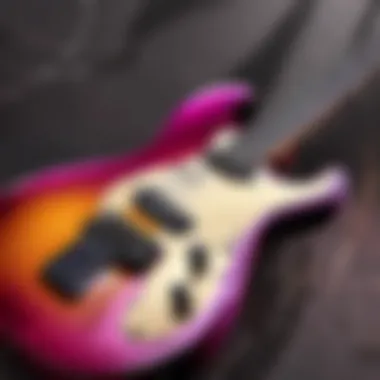Unveiling the Power Chord: A Complete Guide to Mastering Guitar Technique


Champion Spotlights
Power chords, a foundational aspect of guitar-playing, are akin to new champions in the world of League of Legends. Just as summoners eagerly await the release of a new champion to master its unique abilities, guitar enthusiasts delve into the realm of power chords for their distinct sound and versatility. Let's analyze power chords as we would a newly unveiled champion, breaking down their origins, mechanics, and strategic applications to empower musicians on their musical journey.
Gameplay Tips and Strategies
Drawing parallels between mastering power chords and refining gameplay strategies in League of Legends illuminates the importance of early game tactics. Much like securing objectives and gaining advantages in the early stages of a match can set the tone for victory, honing the basics of power chord execution forms the foundation for intricate guitar compositions. Furthermore, just as team fighting strategies are crucial for coordinated gameplay in League of Legends, understanding how power chords complement melodies and harmonies is key to creating compelling musical arrangements that resonate with listeners.
Patch Updates
In the dynamic world of music, as in esports, staying updated on the latest trends and innovations is paramount. Just as patch notes in League of Legends introduce changes that shape the game's meta, advancements in guitar techniques, including power chords, redefine musical styles and genres. Analyzing these shifts not only enhances our appreciation for the art form but also provides invaluable insights into adapting and evolving as musicians in an ever-changing landscape of creativity and expression.
Community News
Similar to the vibrant community surrounding League of Legends, the music community thrives on collaboration, innovation, and collective celebration. Esports events and tournaments parallel music festivals and concerts, showcasing the pinnacle of skill and talent in their respective fields. Likewise, community spotlights in music highlight the grassroots efforts, projects, and initiatives that enrich the cultural tapestry of guitar enthusiasts, amplifying diversity and inclusion within the tight-knit community.
Bonus Content
Delving deeper into the lore of power chords unveils a rich tapestry of musical history, akin to exploring the backstory and lore of champions and regions in League of Legends. Understanding the origins and evolution of power chords adds depth and context to their execution, enriching the musician's narrative and creative palette. Moreover, showcasing fan creations inspired by the mesmerizing soundscapes nurtured through power chords resonates with the fan art, visual storytelling, and creative endeavors thriving within the League of Legends fandom.
Introduction to Power Chord
In the vast realm of guitar playing, mastering the power chord is a crucial skill that sets the foundation for creating compelling music. The power chord's significance stems from its ability to deliver a robust and impactful sound, making it a staple in various musical genres like rock and metal. Understanding the basics of power chords is essential for both aspiring musicians and seasoned players to harness the full potential of this guitar technique.
Understanding the Basics
Definition and Structure of Power Chords
Delving into the definition and structure of power chords unveils a fundamental aspect of this technique. Power chords are comprised of the root note and the fifth interval, creating a chord with a strong, harmonious sound. The simplicity and versatility of power chords make them a popular choice among guitarists looking to add depth and intensity to their music. By mastering the structure of power chords, players can unlock endless possibilities in their musical compositions.


Historical Evolution
Exploring the historical evolution of power chords sheds light on their roots and evolution in music. Originating in the realm of blues and rock music, power chords have evolved to become a cornerstone of modern guitar playing. Their journey through different musical eras showcases their adaptability and timeless appeal. Understanding the historical development of power chords provides valuable insights into their significance and continued relevance in contemporary music.
Components of a Power Chord
Root Note
The root note serves as the foundation of a power chord, dictating its tonal center and defining its character. Guitarists often rely on the root note to establish the key of a song and create melodic structures around it. The rich, full-bodied sound of the root note forms the backbone of power chords, adding depth and resonance to musical compositions.
Fifth Interval
Incorporating the fifth interval into a power chord enhances its harmonic richness and stability. The fifth interval complements the root note, providing a perfect fifth above it and reinforcing the chord's sound. This interval contributes to the powerful and dynamic nature of power chords, making them a versatile choice for crafting impactful melodies and riffs.
Notation and Symbols
Tablature Representation
Tablature representation offers guitarists a visual and intuitive way to learn and play power chords. Tab notation simplifies complex musical arrangements into easy-to-follow diagrams, allowing players to grasp chord progressions effortlessly. Mastering tablature representation enables guitarists to quickly pick up new songs and experiment with different chord variations.
Chord Diagrams
Chord diagrams provide a comprehensive overview of power chords on the fretboard, illustrating finger placements and string positions. By studying chord diagrams, guitarists can enhance their understanding of chord structures and transitions. Visualizing chord shapes through diagrams streamlines the learning process and empowers players to expand their repertoire with diverse chord voicings.
Playing Techniques
In the realm of guitar playing, mastering the art of playing techniques holds paramount importance. This section of the article focuses on elucidating the intricacies of playing techniques, shedding light on specific elements, benefits, and considerations essential to honing this craft. Understanding the nuances of proper playing techniques not only enhances the quality of sound produced but also refines the overall musical expression. It is crucial for aspiring musicians and seasoned players alike to delve deep into the realm of playing techniques to elevate their guitar proficiency.
Finger Placement and Hand Positioning
Optimal Finger Placement


Delving into the realm of optimal finger placement elucidates a crucial aspect of guitar mastery. Optimal finger placement refers to the strategic positioning of fingers on the fretboard to achieve maximum dexterity and precision while playing. The key characteristic of optimal finger placement lies in its ability to facilitate seamless transitions between chords and notes, resulting in a smooth and harmonious sound output. Guitarists opt for optimal finger placement due to its proven efficacy in enhancing speed, accuracy, and overall playing proficiency. Embracing optimal finger placement enables players to navigate complex chord progressions effortlessly, unleashing their full musical potential.
Avoiding Common Mistakes
Unearthing the significance of avoiding common mistakes in finger placement and hand positioning is instrumental in refining one's guitar skills. By steering clear of prevalent errors such as incorrect finger placement, sloppy technique, or tension in hand positioning, players can ensure a fluid and professional playing experience. The key characteristic of avoiding common mistakes lies in rectifying ingrained habits that impede progress and hinder musical development. Opting to evade common pitfalls paves the way for a more efficient and rewarding practice session, leading to continuous improvement in guitar playing. Embracing a proactive approach to thwarting common mistakes empowers players to elevate their performance and achieve mastery in their musical journey.
Strumming Patterns
Delving into the intricate world of strumming patterns unveils a realm of musical possibilities essential for guitar enthusiasts. Understanding variations and dynamics in strumming patterns enriches the musical tapestry, offering nuanced expressions and tonal textures. The key characteristic of variations and dynamics lies in their versatility, allowing players to evoke a range of emotions and styles through rhythmic intricacies. Embracing different strumming patterns adds depth and dimension to musical performances, creating a dynamic auditory experience for both players and listeners.
Syncopation
Exploring the rhythmic intricacies of syncopation introduces a distinctive element to guitar playing, enhancing musical expressiveness and creative flair. Syncopation involves accentuating off-beat notes or emphasizing unexpected rhythmic patterns, injecting a sense of groove and complexity into the music. The key characteristic of syncopation lies in its ability to break away from conventional rhythms, infusing compositions with a unique and captivating rhythmical essence. Embracing syncopation expands the horizons of musical expression, allowing players to craft engaging and dynamic performances that captivate audiences and showcase their artistic prowess.
Palm Muting
Unraveling the techniques of palm muting unveils a realm of tonal versatility and expressive possibilities for guitarists of all levels. Mastering techniques for beginner to advanced players empowers individuals to harness the distinctive sound of palm muting across various musical genres. The key characteristic of techniques for palm muting lies in their capacity to control the sustain and timbre of notes, resulting in punchy, percussive sounds. Embracing palm muting techniques enables players to imbue their playing with a subtle rhythmic drive and dynamic contrast, adding depth and intensity to their musical renditions.
Advanced Applications
Power Chord Progressions
Common Progressions in Rock and Metal
Understanding the nuances of common progressions in rock and metal music is essential for individuals looking to expand their musical repertoire. These progressions, characterized by their raw energy and intensity, contribute immensely to the overall tone and style of a composition. By mastering common progressions, players can infuse authenticity and power into their music, making it resonate with audiences on a deeper level. While these progressions offer a sense of familiarity and comfort, they also challenge musicians to explore the boundaries of creativity within established musical frameworks.
Creating Your Own Sequences
The ability to create unique and personalized chord sequences is a hallmark of an accomplished musician. By crafting original sequences, players can imprint their signature sound onto their music, setting themselves apart in a competitive industry. Creating your own sequences not only enables artistic expression but also fosters innovation and experimentation. However, this creative freedom comes with the responsibility of ensuring coherence and musicality in the compositions. Players must strike a balance between tradition and innovation, leveraging their creativity to construct compelling chord progressions that captivate listeners.
Incorporating Power Chords in Songwriting


Harmonizing with Melodies
Harmonizing power chords with melodies is a sophisticated technique that adds depth and richness to musical compositions. By blending power chords seamlessly with melodic elements, musicians can create a harmonious interplay of sound that elevates the emotional impact of their music. This technique allows players to explore the full spectrum of tonal possibilities, harmonizing different voices within a piece to create a cohesive and immersive listening experience. However, mastering this technique requires precision and finesse, as harmonizing with melodies demands a keen ear for musical nuances and a deep understanding of chord relationships.
Emphasizing Rhythmic Drive
Emphasizing rhythmic drive in power chord compositions infuses them with momentum and energy, driving the musical narrative forward with compelling force. By focusing on rhythmic patterns and accents, players can create dynamic and engaging arrangements that hold the listener's attention from start to finish. Emphasizing rhythmic drive empowers musicians to experiment with tempo, syncopation, and rhythm variations, adding layers of complexity and intrigue to their music. However, maintaining a balance between rhythmic intensity and melodic clarity is crucial to ensuring that the musical journey remains coherent and impactful.
Exploration of Alternative Tunings
Drop Tuning
Drop D tuning is a popular alternative tuning technique that revolutionizes the tonal possibilities of power chords. By lowering the sixth string of the guitar to D, players can achieve a heavier, darker sound ideal for rock and metal genres. Drop D tuning enhances the resonance and depth of power chords, allowing musicians to explore new sonic textures and tonalities. However, transitioning to Drop D tuning requires adjustments in fingering and chord voicings, presenting a challenge for players accustomed to standard tuning. Despite its challenges, Drop D tuning offers a gateway to a sonic landscape rich in intensity and aggression, expanding the creative horizons of guitarists seeking to push the boundaries of traditional music.
Open Chord Variations
Exploring open chord variations offers players a malleable canvas on which to paint their musical ideas. Open chords provide a sense of openness and airiness to compositions, enriching them with warm and vibrant textures. By incorporating open chord variations in power chord progressions, musicians can add complexity and color to their music, creating an evocative and immersive listening experience. However, mastery of open chord variations demands a keen understanding of chord voicings and transitions, as well as the ability to blend different chord types seamlessly. Players who embrace open chord variations unlock a treasure trove of harmonic possibilities, shaping their musical identity and artistic voice with finesse and creativity.
Technical Insights
Sound Modulation and Effects
Distortion and Overdrive
Delay and Reverb
Conclusion
Summarizing Key Points
Mastery through Practice
Embarking on the journey of mastering power chords necessitates a dedicated commitment to practice. 'Mastery through Practice' forms the core foundation of honing this essential guitar technique. Consistent and focused practice enables musicians to cultivate muscle memory, refine finger dexterity, and develop an acute ear for harmonic intervals. The iterative process of practicing power chords not only solidifies technical proficiency but also fosters a deeper understanding of chord structures and voicings. This systematic approach empowers guitarists to tackle complex chord progressions with precision and confidence, ultimately enhancing their musical repertoire.
Continuous Exploration
The pursuit of guitar excellence extends beyond mastery through practice; it embodies a spirit of continuous exploration. 'Continuous Exploration' underscores the significance of pushing artistic boundaries, experimenting with new musical concepts, and embracing creative innovation. By continuously exploring various power chord progressions, effects, and playing styles, musicians can expand their sonic palette and nurture a distinct musical identity. This proactive approach to exploration fosters a lifelong commitment to growth and artistic evolution, resonating with passionate guitar enthusiasts dedicated to pushing the boundaries of musical creativity and expression.







